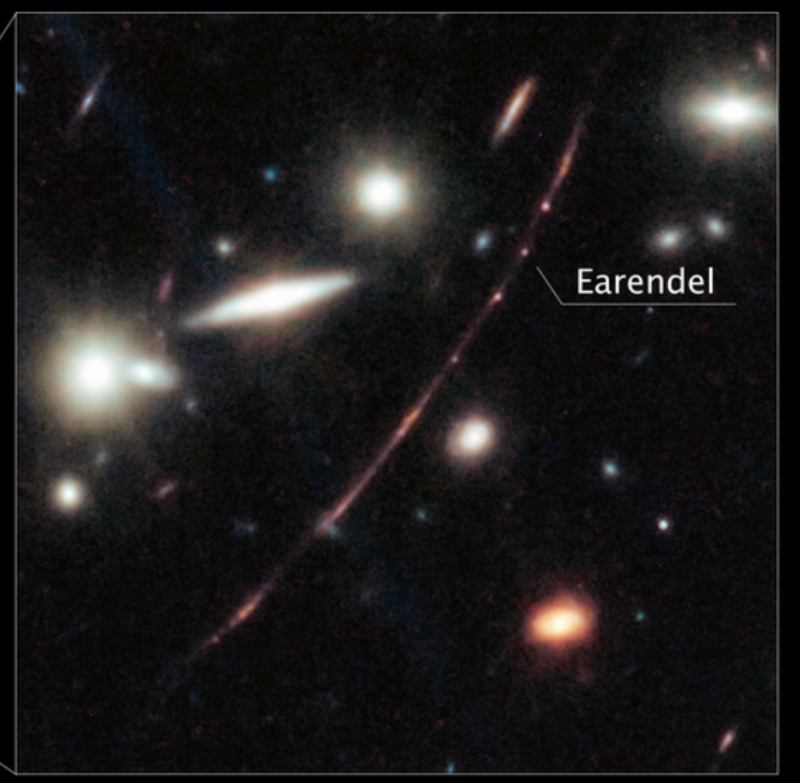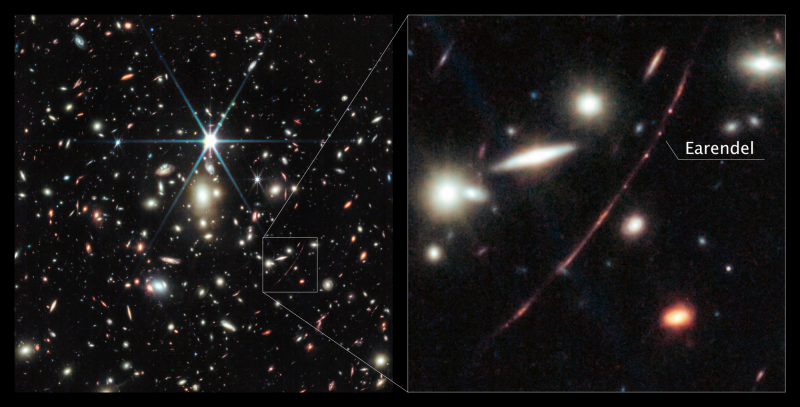
In early 2022, the Hubble Space Telescope spied the most distant star anyone has yet seen. Astronomers named it Earendel, the Old English word for ‘morning star’. In August 2023, NASA announced a new image of Earendel that reveals its true colors, so to speak. The analysis of Earendel’s colors shows it likely has a stellar companion. Original article by NASA. Edits by EarthSky.
Earendel, the most distant star
NASA has used the Webb space telescope to follow up on observations of the farthest star. This star – called Earendel – emitted the light we now see some 12.9 billion years ago. So it exists in a realm of space just 900 million years after the Big Bang. Because the universe has expanded in the time it took this light to reach us, Earendel is now 28 billion light-years away from us.
Webb’s NIRCam (Near-Infrared Camera) instrument reveals the star to be a massive B-type star more than twice as hot as our sun and about a million times more luminous.
The star, which the research team has dubbed Earendel, is part of the Sunrise Arc galaxy. Now, gravitational lensing enables astronomers to see this distant star. Both Hubble and Webb were able to detect Earendel due to its lucky alignment behind a wrinkle in spacetime created by a massive galaxy cluster. The galaxy cluster lies between us and Earendel. Indeed, it’s so massive that it warps the fabric of space itself, which produces a magnifying effect. This allows astronomers to look through the cluster like a magnifying glass.
The most distant known stars
Other features in the galaxy appear multiple times due to the gravitational lensing. Earendel, however, only appears as a single point of light even with Webb. Based on this, astronomers determined the object is magnified by a factor of at least 4,000 and is thus extremely small. Moreover, we’re seeing it at just one billion years after the Big Bang. Previously, Hubble had found the previous record-holder for the most distant star, at around four billion years after the Big Bang. Then, another research team using Webb recently identified a gravitationally lensed star they nicknamed Quyllur. Quyllur is a red giant star existing three billion years after the Big Bang.
The colors of Earendel
Stars as massive as Earendel often have companions. Astronomers did not expect Webb to reveal any companions of Earendel since they would be so close together and indistinguishable on the sky. However, based solely on the colors of Earendel, astronomers think they see hints of a cooler, redder companion star. This light has been stretched by the expansion of the universe to wavelengths longer than Hubble’s instruments can detect, and so it was only detectable with Webb.

The Sunrise Arc
Webb’s NIRCam also shows other notable details in the Sunrise Arc. For example, this galaxy is the most highly magnified galaxy yet detected in the universe’s first billion years. Features include both young star-forming regions and older established star clusters as small as 10 light-years across. On either side of the wrinkle of maximum magnification, which runs right through Earendel, the gravitational lens mirrors these distorted features.
The region forming stars appears elongated. Astronomers estimate it to be less than five million years old. Smaller dots on either side of Earendel are two images of one older, more established star cluster. Researchers estimated it to be at least 10 million years old. They determined this star cluster is gravitationally bound and likely still persists today. This shows us how the globular clusters in our own Milky Way might have looked when they formed 13 billion years ago.
Astronomers are currently analyzing data from Webb’s NIRSpec (Near-Infrared Spectrograph) instrument observations. These observations will provide precise composition and distance measurements for the Sunrise Arc galaxy.
The research team has cautious hope that this could be a step toward the eventual detection of one of the very first generation of stars, composed only of the raw ingredients of the universe created in the Big Bang, hydrogen and helium.

Bottom line: The Webb space telescope has looked at the colors of Earendel, the most distant known star. The new data shows that the star likely has a cooler, redder companion star.











